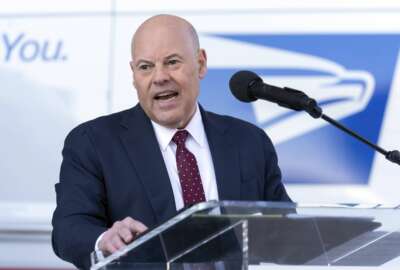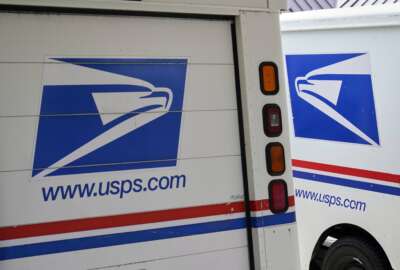DeJoy: USPS needs ‘long overdue’ network changes to keep up with reform goals
Postmaster General Louis DeJoy said Tuesday that “more aggressive cost reductions to operations” are needed to keep USPS’ long-term financial goals within...
The Postal Service is falling short of its goal to turn around its financial losses this year, but is pointing to an ongoing shakeup of its nationwide delivery network as a critical part of its plan to break even by the end of the decade.
Postmaster General Louis DeJoy said Tuesday that “more aggressive cost reductions to operations” are needed to keep USPS’ long-term financial goals within reach — and that USPS reshaping its nationwide delivery network is key to those savings.
“This undertaking is massive and long overdue, and time is of the essence if we wish to enjoy the benefits of this cherished institution for years to come,” DeJoy told the USPS Board of Governors.
USPS reported a $1.7 billion net loss for the third quarter of fiscal 2023, and is expected to see a net loss for the entire fiscal year.
The agency saw a nearly 6% decrease in its first-class mail volume, but reported a 4% — or $221 million— increase in first-class mail revenue, compared to the same period last year.
USPS on July 9 raised the price of a first-class stamp from 63 to 66 cents. The agency is settling into a familiar routine of biannual rate increases for its monopoly mail products each January and July.
USPS saw “relatively flat” revenue from its package business in the third quarter of fiscal 2023, while package volume declined by about 2.4%, compared to the same period last year.
USPS Chief Financial Officer Joe Corbett said the agency is on its way to “long-term, self-sustaining financial health, but there’s plenty of work planned and plenty more to do.”
Corbett said package volume continues to decline, compared to levels seen at the peak of the COVID-19 pandemic. But the agency looking at the recent launch of USPS Ground Advantage to capture more of the competitive package business.
“We look forward to the revenue generation potential it brings to the Postal Service,” he said.
The third-quarter financial results are in stark contrast to the $59.7 billion net income USPS reported for the same quarter last year. But that sudden reversal in USPS finances is almost entirely because of the Postal Service Reform Act, which was signed into law in April 2022.
USPS also reported a nearly 1% decrease in total operating revenue for the quarter, compared to the same period last year.
About 98% of the nation’s population are receiving their mail and packages in less than three days. USPS moves 400 million pieces of mail and packages every day.
DeJoy said USPS recently opened its first Regional Processing and Distribution Center in Richmond, Virginia, and will begin closing many “inefficient” annexes and contracted facilities across the country.
Over the next 17 months, USPS plans to open another nine regional centers, renovate 27 local processing centers, and 60 additional deliver Sorting and Delivery Centers (S&DCs).
“This will be done without closing any local post office retail operations,” DeJoy said.
DeJoy stressed USPS is closing facilities it doesn’t own, and revitalizing the facilities it does own.
DeJoy said 85% of next year’s network modernization investments will go toward existing USPS facilities. These investments, he added, mark the start of USPS addressing $20 billion of deferred maintenance projects.
“Effective accomplishment of these strategies are how the United States Postal Service survives and thrives in the future,” DeJoy said.
Board Chairman Roman Martinez said the network transformation underway is “nothing less than extraordinary in scope and impact.”
Martinez said the network modernization will result in shrinking its footprint of 427 facilities nationwide down to approximately 226.
“Through modernizing our delivery streams, investing in infrastructure, and stabilizing our workforce, we’re beginning to put the Postal Service on a path to financial solvency,” Martinez said.
Martinez said S&DCs will lead to a reduction of 3,000 out of 19,000 facilities.
“While the carriers will no longer be using those 3,000 facilities, most will retain the retail operations to preserve access to the networks,” Martinez said.
Martinez said these network modernization plans are also necessary to support the deployment of over 60,000 electric vehicles over the next five years.
DeJoy said the first electric vehicles will arrive at the end of this year, and that more than 9,000 additional electric vehicles will arrive next calendar year — along with new gas-powered vehicles that will be more fuel-efficient than its legacy fleet.
USPS board member Ronald Stroman, a former deputy postmaster general, also urged the agency to take additional steps to protect its workforce from extreme heat.
USPS under its Heat Illness Prevention Program (HIPP) requires supervisors to give weekly heat safety talks to frontline employees.
“As important as this program is I believe it would be prudent for the Postal Service Plan for the likelihood that this summer is extreme heat, is the new normal, and will get worse in the future,” Stroman said.
Stroman also proposed USPS adjust hours of operation to reduce employees’ exposure to extreme heat, and to consult with experts on heat stress.
“The safety of our employees is our number one priority and we should continue to challenge ourselves to find new and better solutions that help keep our employees safe, especially in this extreme heat,” Stroman said.
Copyright © 2025 Federal News Network. All rights reserved. This website is not intended for users located within the European Economic Area.
Jory Heckman is a reporter at Federal News Network covering U.S. Postal Service, IRS, big data and technology issues.
Follow @jheckmanWFED






